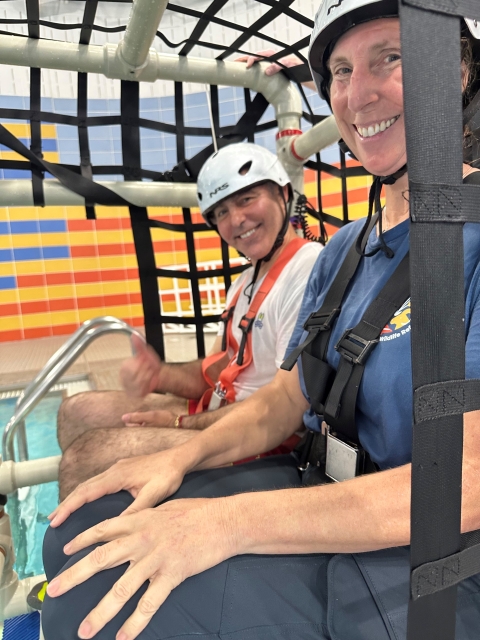The U.S. Fish and Wildlife Service flies in small planes over land and often over water for work. Recently, Director Martha Williams took the Water Ditching and Survival (aka “dunker”) training at Chinquapin Park Recreation Center and Aquatics Facility in Alexandria, Virginia, with Noah Matson, Deputy Assistant Director, Migratory Bird Program, and A. Eric Alvarez, Deputy Chief, National Wildlife Refuge System. Nate Olson, Regional Aviation Manager and pilot biologist, from the Anchorage, Alaska, office led the training.
The dunker exercise takes place in water with qualified instructors ready to lift the dunker up in an instant. It is called a ditch, but a ditch is a crash on water. Those taking the training do a dunk upside down.
“Aviation safety is so important. And the investment we have made in aviation safety and people in conducting these trainings is amazing,” said Director Williams. “Plus, our instructors do a phenomenal job.”
The lifesaving training is required for those participating in overwater aerial missions or conducting water operations in seaplanes. The initial course must be instructor-led and include the actual water exercises. The training teaches a standardized six-step sequence to egressing (leaving) a submerged aircraft cabin in the event of a forced landing or mishap overwater. The course is designed to provide participants with a standardized procedure to utilize during an aircraft water ditching. Subsequent recurrency training can be obtained through an online webinar, however, a periodic repeat of the full course with water exercises is encouraged to maintain skills.
(Watch this video on YouTube at https://www.youtube.com/watch?v=Ub4Z2YF2yo0.)
Also covered during the training are topics such as use of floatation devices, life rafts and water survival techniques.
In the last three years, the Service's Branch of Aviation Management has flown approximately 24,000 hours with 90% on natural resources missions and 10% for training, emergency, transportation and support. These complex activities are routinely performed in diverse terrain and environmental conditions.
The agency has a fleet of 44 airplanes, two helicopters, and 53 Uncrewed Aircraft Systems used by a diverse range of pilots across the United States from Alaska to Maine, including pilot biologists surveying wildlife, law enforcement pilots ensuring our public lands safety and refuge pilots monitoring habitats.
In addition to training delivered by the Service and other bureaus, the Department of the Interior’s Office of Aviation Services also vets and pre-approves commercial training vendors to provide equivalent under water egress and survival training. These commercial vendors are able to instruct in the operation of certain equipment that exceeds Departmental requirements.
For example, the Service’s Division of Migratory Bird Management conducts extensive overwater and offshore missions, and their aircrews carry specialized equipment known as emergency breathing devices. EBDs are essentially small SCUBA tanks that provide a source of emergency air when used properly. Training with these devices can currently only be obtained through commercial sources.
The Service follows a National Aviation Management Plan that is a comprehensive bureau-wide aviation strategy. Aviation training requirements for different roles and involvement in aviation operations are included in the newly updated plan.
We are proud to state the Service marks eight consecutive years without an aircraft accident, a testament to our commitment to safety and dedication to excellence. Thank you to our aviation teams!








